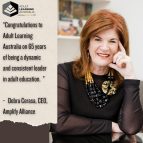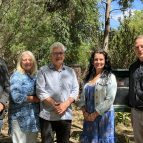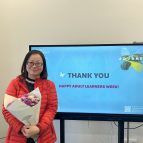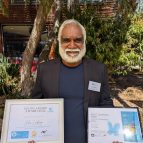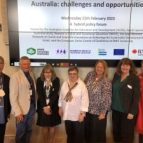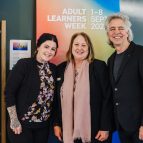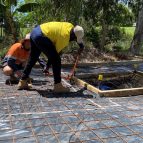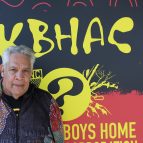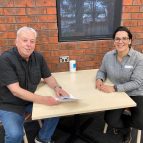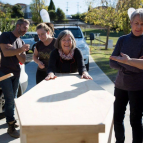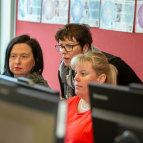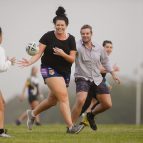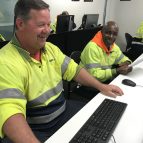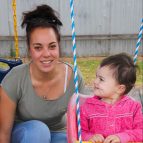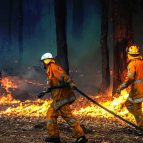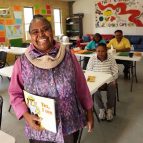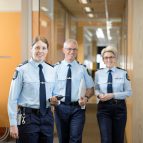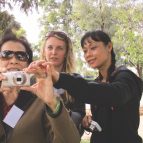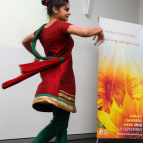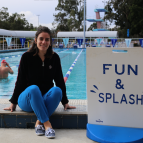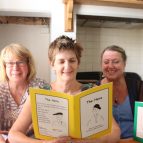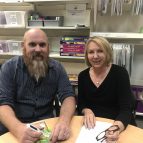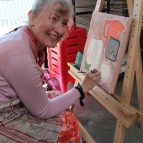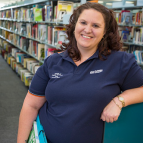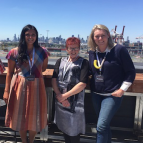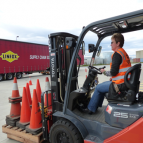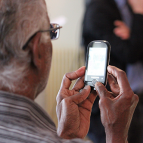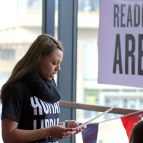Australia’s adult literacy crisis
 Rugby league star turned actor Ian Roberts recently hit the news when he confessed he had only properly learned to read at the age of 36. Roberts, the first openly gay player in the league said coming out as gay was a breeze in comparison to publicly admitting how much difficulty he had with reading and writing.
Rugby league star turned actor Ian Roberts recently hit the news when he confessed he had only properly learned to read at the age of 36. Roberts, the first openly gay player in the league said coming out as gay was a breeze in comparison to publicly admitting how much difficulty he had with reading and writing.
‘I was so ashamed and embarrassed about it. I was basically illiterate,’ he told ABC radio interviewer Julian Morrow recently.
Luckily for Roberts, a teacher found him help.
Roberts’ story and the statistic that around 44% of Australian adults don’t have the literacy skills needed for everyday life was no doubt shocking to many but it’s no surprise to people involved in teaching adults. And experts agree that this statistic is most likely higher because literacy levels in remote parts of Australia are not included in the data.

The national Reading Writing Hotline which refers adults for help with literacy and numeracy saw a spike in calls during COVID. Vanessa Iles, Manager of the service says the 4000 callers to the Hotline each year are just the tip of the iceberg. ‘There are a lot of people out there who are flying under the radar.’
Jo Medlin, President of the Australian Council for Adult Literacy agrees. ‘I think a lot of people are not putting their hand up to having problems because of the social stigma. It takes a lot of courage to admit that you’ve been through the school system in Australia and you can’t read and write. That’s a huge step.’
Shame prevents people getting help
This sense of shame is the reason people keep their secret to themselves and often develop creative ways of avoiding exposure.
‘You notice examples of people hiding their difficulties all the time. For example simple things like using public transport. if you’re waiting at a bus stop sometimes people will say “Excuse me, I can’t read the 24-hour timetable, is this the right bus?” And of course the standard is “Can you read this for me? I have forgotten my glasses” – that’s common too,’ Jo says.
COVID was a confronting event for people with low literacy. Forced into isolation and with community services closed, many people were cut off from helpers. ‘Before COVID people would go to the local library or community centre and get assistance. But during COVID it was like “What do I do now?”‘, Jo says.
‘Learning how to write and read was almost like a rebirth. This whole other world opened up. It was incredible.’ Ian Roberts
Vanessa Iles says that fear of exposure of a problem they had worked hard to hide prompted many callers to seek help. ‘We got calls from a lot of people who had managed to keep their inability to read and write secret from their families and kids, who rang us panicstruck because suddenly they were expected to be involved in home schooling.’
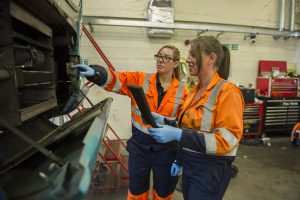
In non COVID times, triggers include the birth of a child, the prospect of a promotion at work or death or separation from a helper. Vanessa says that rising standards of literacy required at work is a common reason for people to call for help. ‘For example, someone who has been a truck driver for 20 years who when they started didn’t need to do much more than sign their name will ring because they find that now they are expected to take part in very complex online processes and complete mandatory safety training. So the requirements for the job have changed.’
For Ian Roberts the trigger was the realisation that if he wanted to be an actor, he would have to learn his lines. And for that he needed to be able to read.
Myths about adult literacy
There’s a common misconception that the only people with literacy problems are new migrants. But in 2020, 68% of callers to the Reading Writing Hotline were from English speaking backgrounds and went through school in Australia. Another mistaken belief is that it is young people who don’t have the literacy skills for work and study. ‘If you listen to talk back radio you hear people reminiscing about a golden age where everyone learned to read and write at school. But I’ve taught people in their 60s who never went to high school,’ Jo says.
The PIAAC data bears this out with older Australians 60+ with the lowest literacy rates. And 60% of callers to the Reading Writing Hotline are men, mostly in the 44–65 age group.
So how is it that so many people who went through school in Australia are struggling to read and write?
Research has found a range of reasons why people don’t develop the skills they need — particularly in the crucial years between 5 and 9 when most kids develop reading skills. Parents with low literacy; disrupted schooling, poverty, learning difficulties, eyesight or hearing problems, and family breakdown are some of the reasons why children can grow into adults without reading and writing skills.

Limited adult literacy services
Asking for help is one thing, getting it is another. Government funded adult literacy services are available for jobseekers in the form of the ‘Skills for Employment and Education’ (SEE) program. But 82% of callers to the Reading Writing Hotline are stay-at-home parents, already working, retired or carers, so are not eligible for free adult literacy help, Vanessa Iles says.
Getting help is also complicated by where you live. Services across Australia are often piecemeal and patchy outside of metropolitan areas with some states having little or no provision. ‘If someone is calling from Melbourne they have lots of options. If they’re calling from a rural area it’s a very different story’, Vanessa says.
The existence of a national Hotline sets up expectations that help will be available. ‘The model of a hotline implies that you take calls and plug people into services. But we’ve had a huge increase in people we can’t find classes for, up from 4% to 13%.’
‘It can take people 10–15 years to call us and they finally ring thinking “OK I’m ready to unburden myself and deal with the embarrassment and shame.” We hate saying “Sorry there’s nothing for you,”’ Vanessa Iles says.
‘Some people develop fantastic strategies for coping and can lead what look like successful lives. For example, tradies who rely on their wife or their partner to do the paperwork. But if they’re separated all that falls apart.’ Jo Medlin, President, ACAL
Everyday adult literacy focus first
Ros Bauer, Adult Learning Australia (ALA) Board, says that the recently convened parliamentary inquiry into adult literacy is an opportunity to influence public policy.
‘Formal and accredited VET training incorporating foundation skills and offering pathways for work or further study are important but they presuppose that learners already have the literacy skills needed. How can you develop a resume or write a job application if you don’t have those basic reading and writing skills?
‘The kind of everyday reading and writing that people who have lower levels of literacy need — how to read a school newsletter or an electricity bill, for example — are not the focus of accredited training.’

Using successful programs as models
Learner centred programs are key. ‘For people who left school early or had bad experiences of school it’s a big step to come back to learning. They often come in with a mistrust of the system so programs that are going to be effective are ones where the learner feels safe and supported and where the emphasis is not on pushing them through a curriculum but helping them to learn what they want to know.
‘We know that some of the most successful initiatives, ones that work for people who are hard-to-reach and disengaged, are delivered through community education programs. These kinds of face to face, non-threatening and non-accredited programs are suited to people with low level skills and tailored to their needs.’
Mapping current adult literacy services
Ros says the first step in developing suitable services across Australia would be to find out what is available. Currently, adult and community education (ACE) literacy and numeracy programs are offered by a range of different organisations, for different purposes, by a mix of paid and volunteer staff. Mapping this would enable us to get a good picture of what’s on offer, identify gaps and look for opportunities for partnerships.
Supporting those organisations who are doing it well is crucial, Ros says. And while the ACE sector is well placed to offer programs for people with low literacy, in some states and territories the sector has been dismantled. ‘Support and development for not-for-profit community education would be key to any national strategy.’
Training for adult literacy teachers is crucial
But the urgent and unacknowledged issue is the lack of training available for the adult literacy workforce. And it is a problem made worse by the imminent loss of experienced and qualified teachers who are reaching retirement age.
‘We really need to focus on developing the skills of the whole gamut of practitioners working in this space — from ACE and VET teachers to volunteers and everyone in between — so that we have people on the ground who can respond and assist in a meaningful way.
‘ALA’s vision is to deliver tailored professional development that addresses individual needs, which is crucial for a workforce that is highly casualised and under-resourced. An online professional development portal would enable practitioners to connect with others working in the field, share resources and forge links and develop a national community.’
History of public awareness of adult literacy
The prevalence of poor literacy amongst Australians first entered the public consciousness during World War 2. Officers in the Australian army were surprised and troubled by the rate of ‘illiteracy’ amongst their men. Deprived of the helpers and scribes who covered for them back at home — the wives, mothers, and siblings — and posted overseas, the numbers of Australian soldiers who had difficulty reading and writing were suddenly exposed.
The army established an Adult Education Unit to deal with the problem and noted ‘how grateful the illiterates were to get this assistance.’ But the benefits went both ways. An army that could read documents, decipher maps, understand navigation and follow written orders was crucial.
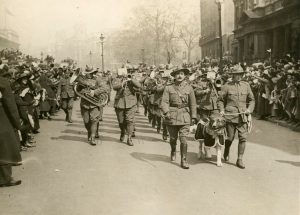
After World War 2, adult literacy education continued in a different form. Returned servicemen could attend Workers Education Associations, libraries and local organisations for the purposes of self-education.
Public awareness of just how many Australians had fallen through the education cracks grew in the decades that followed. Adult education advocates like Arch Nelson successfully pitched adult literacy into the government and public consciousness in the 1970s. But it wasn’t until the 1980s and 1990s that adult literacy in a more organised form took off in Australia. In the process the field’s early emphasis on social justice narrowed to a purely vocational focus.
From social justice to workplace training
According to Pamela Osmond, adult literacy teacher and author of a recently published book about the history of adult literacy education in NSW, the early decades of the adult literacy field were founded on ideals of social justice. Whatever reason someone wanted to improve their literacy — for work, social or personal reasons — all were equally valid.
But by the late 1990s, the global economic crisis had shifted the narrative so that anything that didn’t contribute to economic prosperity was deemed irrelevant. ‘With the economic downturn TAFE and adult basic education and adult literacy services were coopted into the process of industrial reform and became part of the mainstream. Once adult basic education was assimilated into the National Training Reform Agenda the rest of the role was forgotten. The focus of adult literacy became workplace and training,’ Pamela says.
And we’ve been stuck in that narrative ever since.
See the full issue of Quest 1, 2021

